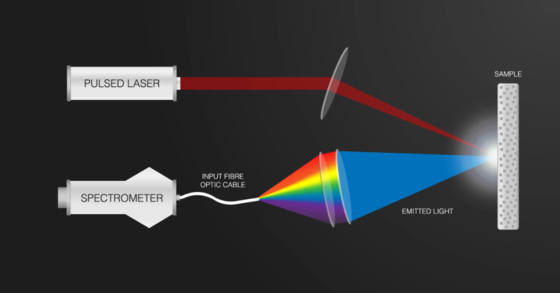Laser Induced Breakdown Spectroscopy
Laser Induced Breakdown Spectroscopy (LIBS) is a powerful rapid chemical analysis technique that combines automated laser micro-sampling with an optical emission spectrograph to characterize relative element abundances and element distribution in solid samples.
LIBS uses a focused high-energy pulsed laser to remove nanograms to picograms of material as the laser passes over a sample surface. The laser causes the formation of a micro-plasma that atomizes and ionizes the sample material, which rapidly undergoes expansion and cooling. During this time, the atomized and ionized elements present in the plasma produce characteristic light emission lines in the near infrared to deep ultraviolet range. A spectrometer is located above the sample stage, and allows for simultaneous acquisition of the entire wavelength range produced by all present elements. The indirect measurement of sample composition by the spectrometer makes LIBS particularly powerful for atmosphere sensitive samples and is currently in use by NASA’s Mars rovers.

LIBS is particularly useful for depth analysis, as the laser can be re-focused on the same location of a sample surface and provide depth profiling at a resolution of 100’s of nanometers per pass, depending on the sample matrix. In addition, a range of laser spot sizes is available (~20-200 µm), and a sub-micron resolution motorized sample stage allows for the laser to scan over a sample surface, providing spatially resolvable elemental maps, allowing for multivariate statistical analysis. LIBS can detect any naturally occurring element down to down to parts-per-million levels, depending on the sample matrix.
Ideal Uses of LIBS
- Rapidly survey chemical composition of solid materials
- Elemental distribution analysis and micron-scale mapping of trace elements
- Depth profiling
Strengths
- Direct elemental analysis of any solid material
- Analysis without pre-preparation
- Analysis of atmosphere sensitive materials
- Spatial distribution analysis/mapping
- All elements detectable
Limitations
- Strong matrix effects on emission spectra
- Matrix-matched reference materials must be analyzed alongside samples for quantitative analysis
LIBS Technical Specifications
- Species Detected: elemental optical emission lines
- Sensitivity: parts per millions (ppmw)
- Depth Resolution: >0.1 μm
- Typical Spot Size: 20 – 200 μm
